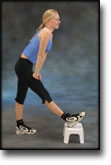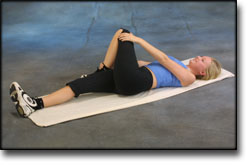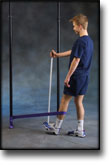|
The piriformis syndrome. |
Kategoriarkiv: Buttock
treatment-article1
|
Piriformis syndrome: assessment of current practice and literature review. |
examination-article
|
The piriformis muscle syndrome: a simple diagnostic maneuver. |
step4
Training ladder for:
BURSITIS AT THE OUTER FEMORAL BONE PROJECTION
(BURSITIS TROCHANTERICA)
STEP 4 |
Unlimited: Cycling. Swimming. Running.
|
||||||||||||||||||||||||||||||||||||||||||||||||
|
Stretching is carried out in the following way: stretch the muscle group for 3-5 seconds. Relax for 3-5 seconds. The muscle group should subsequently be stretched for 20 seconds. The muscle is allowed to be tender, but must not hurt. Relax for 20 seconds, after which the procedure can be repeated. The time consumed for stretching, coordination and strength training can be altered depending on the training opportunities available and individual requirements. |
step3
Training ladder for:
BURSITIS AT THE OUTER FEMORAL BONE PROJECTION
(BURSITIS TROCHANTERICA)
STEP 3 |
Unlimited: Cycling with raised saddle. Swimming.
|
|||||||||||||||||||||||||||||||||||||||||||||||||||||
|
Stretching is carried out in the following way: stretch the muscle group for 3-5 seconds. Relax for 3-5 seconds. The muscle group should subsequently be stretched for 20 seconds. The muscle is allowed to be tender, but must not hurt. Relax for 20 seconds, after which the procedure can be repeated. The time consumed for stretching, coordination and strength training can be altered depending on the training opportunities available and individual requirements. |
step2
Training ladder for:
BURSITIS AT THE OUTER FEMORAL BONE PROJECTION
(BURSITIS TROCHANTERICA)
STEP 2 |
Unlimited: Cycling with raised saddle. Swimming. Light jogging.
|
|||||||||||||||||||||||||||||||||||||||||||||||||||||||||||
|
Stretching is carried out in the following way: stretch the muscle group for 3-5 seconds. Relax for 3-5 seconds. The muscle group should subsequently be stretched for 20 seconds. The muscle is allowed to be tender, but must not hurt. Relax for 20 seconds, after which the procedure can be repeated. The time consumed for stretching, coordination and strength training can be altered depending on the training opportunities available and individual requirements. |
step1
Training ladder for:
BURSITIS AT THE OUTER FEMORAL BONE PROJECTION
(BURSITIS TROCHANTERICA)
STEP 1 |
| The indications of time after stretching, coordination training and strength training show the division of time for the respective type of training when training for a period of one hour. The time indications are therefore not a definition of the daily training needs, as the daily training is determined on an individual basis.
|
||||||||||||||||||||||||||||||||||||||||||||||||
|
Stretching is carried out in the following way: stretch the muscle group for 3-5 seconds. Relax for 3-5 seconds. The muscle group should subsequently be stretched for 20 seconds. The muscle is allowed to be tender, but must not hurt. Relax for 20 seconds, after which the procedure can be repeated. The time consumed for stretching, coordination and strength training can be altered depending on the training opportunities available and individual requirements. |

ultrasonic-image

treatment-article
|
Ischial tuberosity apophysitis and avulsion among athletes. |
step4
Training ladder for:
TRAINING LADDER AFTER RUPTURE OF THE POSTERIOR THIGH MUSCLE FASTENING ON THE ISCHIATIC BONE
(RUPTURA MUSCULI)
STEP 4 |
Unlimited: Cycling. Swimming. Running with intermittent sprints.
|
||||||||||||||||||||||||||||||||||||||||||||||||||||||||
|
Stretching is carried out in the following way: stretch the muscle group for 3-5 seconds. Relax for 3-5 seconds. The muscle group should subsequently be stretched for 20 seconds. The muscle is allowed to be tender, but must not hurt. Relax for 20 seconds, after which the procedure can be repeated. The time consumed for stretching, coordination and strength training can be altered depending on the training opportunities available and individual requirements. |














































